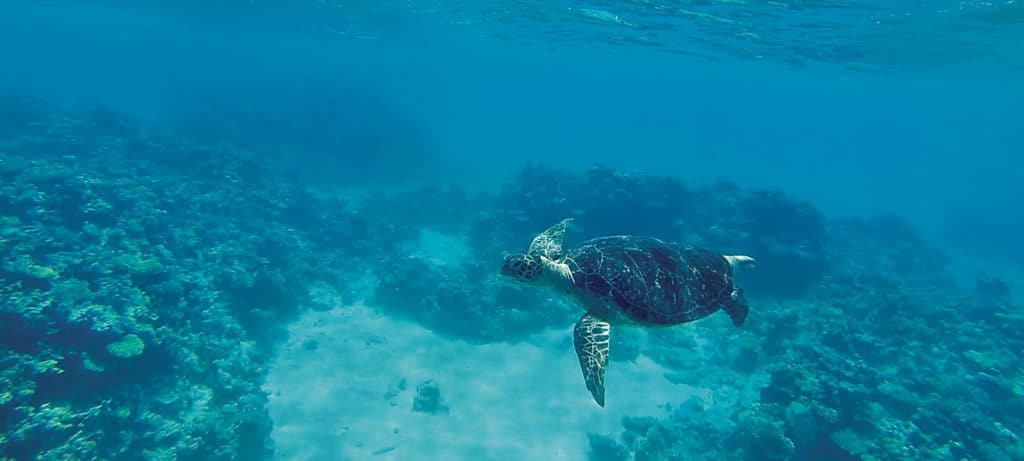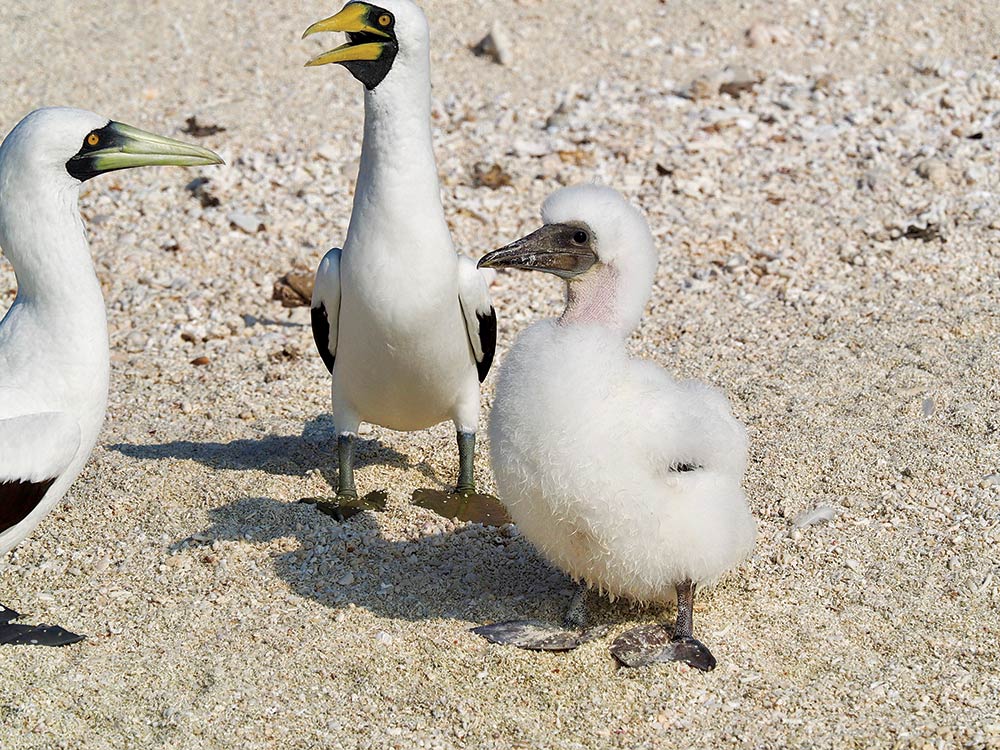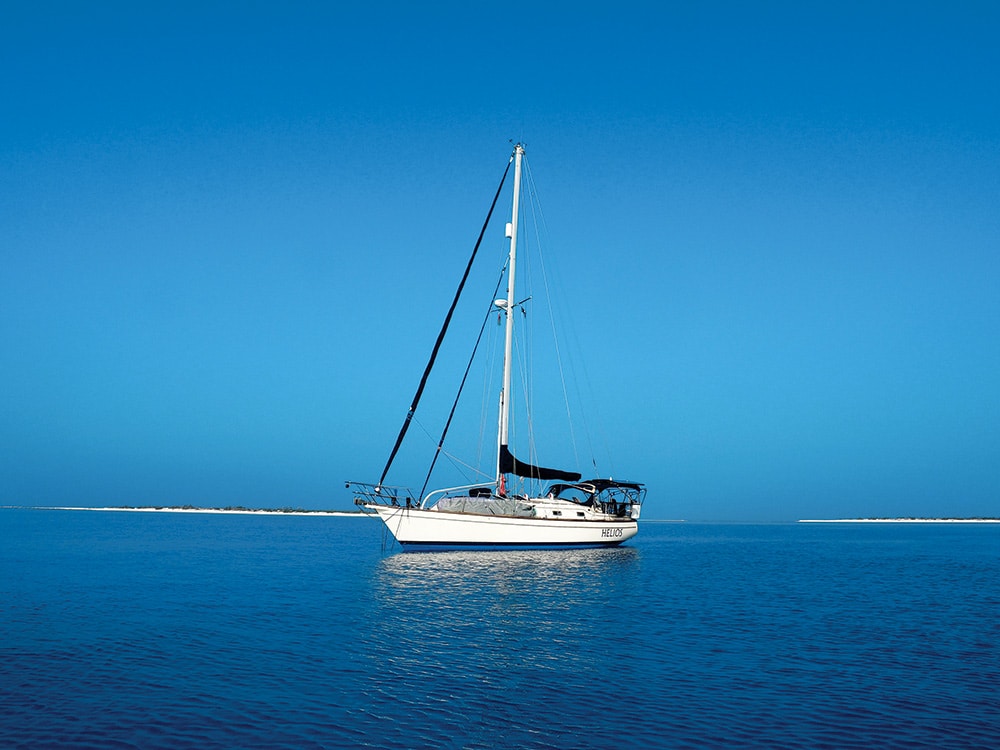
My husband, Dominic, and I were wetsuited up, in our dinghy and poised for a dive when we saw a vessel enter the pass of Chesterfield Reef that had been incognito on our automatic identification system. We circled after it anchored, and discovered the reason behind the ship’s secrecy: men wearing waders harvesting from nets in the water, either husking shellfish or finning sharks within the parameters of New Caledonia’s protected waters.
It’s no surprise that Chesterfield Reef attracts such unwelcome visitors. One of only a handful of atolls sprinkled in the Coral Sea between New Caledonia and Australia, the thriving reef is a haven for migrating marine life as well as breeding turtles and birds. As of 2010, Chesterfield and its neighbor Bellona housed upward of 43,000 pairs of mating boobies, frigate birds and noddies.
Shaped like a bent fishhook, the reef is easy to enter and navigate. There are 11 motus surrounding the lagoon that form a bight along the southern end, creating an anchorage protected from southerly trades and a lagoon that rivals any post- card from paradise.
By 12:30 on a sunny Saturday in November, our anchor was dropped, the champagne popped and we were moments away from swimming in the glassy turquoise water surrounding the boat. Three other cruising yachts were with us: two catamarans out of Australia and Breeze, a 64-foot Moody, out of Sweden.
We quickly realized those calm, clear waters were not as benign as they looked — Breeze reported seeing a 10-foot tiger shark circling their stern. The reef system provides year-round shelter to an adult male tiger shark and at least three juveniles. A 2014 study recorded adult females passing through the area as part of a three-year migratory pattern around the Coral Sea via Australia and southern New Caledonia.

We tentatively, cautiously, on high shark alert at all times, did some under- water exploring of the coral near the anchorage. The water was diamond clear, and the rock formations were swollen with coral, humming with sh of all sizes. Crimson and evergreen sea fans waved in the current.
Returning to Helios, our Island Packet 380, we captured images of the vessel we spotted entering the pass harvesting wildlife from within the reef. There were two illegal fishing boats while we were in Chesterfield — a large “mothership” that lingered outside the reef and a smaller satellite “junker” that worked inside the lagoon.

Chesterfield Reef and the surrounding waters are part of New Caledonia’s exclusive economic zone, meaning foreign commercial vessels without permission are forbidden from shing in the region. Similarly, New Caledonia has recently designated the waters within the EEZ as a natural park, limiting domestic fishing and hoping to eventually extend protection as far as Australia’s aquatic preserve to the west.
Nevertheless, it isn’t uncommon to find illegal fishing boats from the north working in the area. Within the Coral Sea in recent years, vessels from Vietnam, China, Taiwan and Papua New Guinea have been caught harvesting large amounts of sea cucumbers, tuna, sharks and smaller quantities of turtle meat and reef fish. In the past five years, the Secretariat of the Pacific Community has recorded as many as 320 illegal, unreported and unregulated fishing vessels within the greater South Pacific Ocean in a one-month period.
Outraged as we were by the illegal fishing going on around us, there was little we could do. Breeze attempted radio contact with both vessels. We took photos, sending them to New Caledonia’s navy, which replied to us at once. As much as we wanted to do more, the officer discouraged any direct confrontation because the potential for violence could escalate.
Exploring the atoll, however, it was hard to not be reminded of life’s capacity to endure. Amid human refuse and dwindling atoll real estate, masked boobies sat on eggs and raised their young on the sand, red-footed boobies built nests in the bushlike trees and black noddies roosted on low-lying shrubs, raising their offspring in the shade below.
On our third day at the reef, the winds backed to the northerly quarter, which kicked up chop in the lagoon. We were in for a bumpy night no matter our location, so we moved to the western side of the reef to explore a second anchorage and be nearer to the southwesterly pass for our exit the following day.
We dived the reef system between Helios and shore and found more vibrant coral and schools of emperor sh. We were awestruck when a 4-foot turtle emerged out of the blue, swam directly at us and circled three times. How wondrous to be approached with innocent curiosity when we, humans, are so much more deserving of fear.








